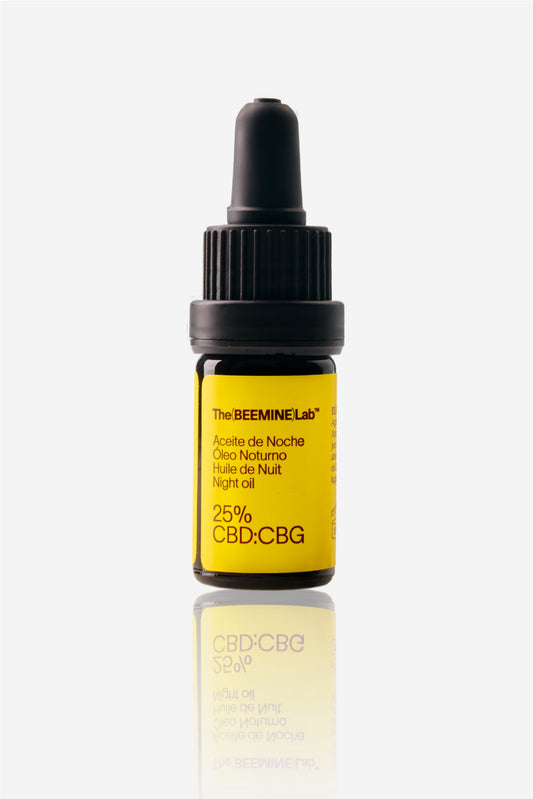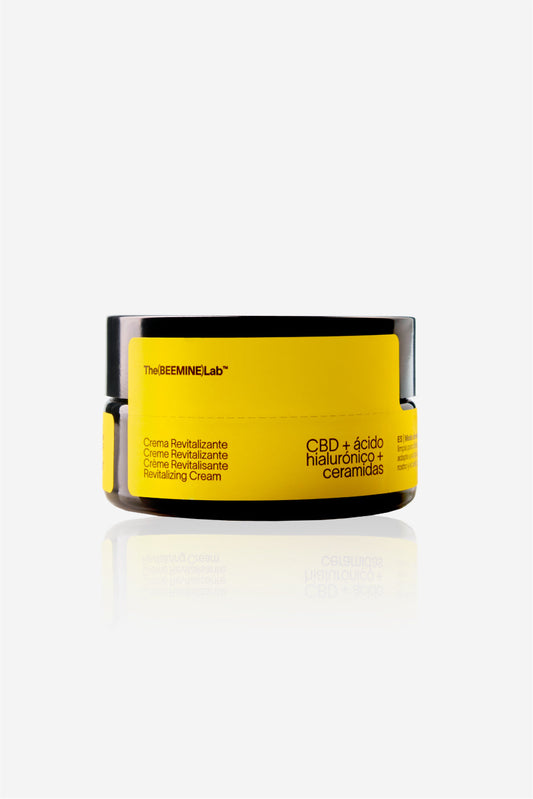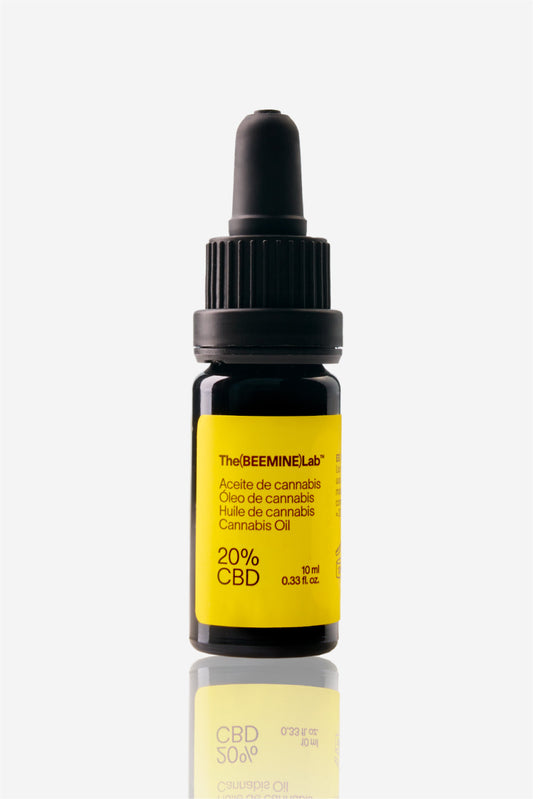The latest scientific advances on the health benefits of CBD, along with its ever-increasing popularity, have turned the production and distribution of CBD products into a new opportunity for business, development and innovation.
At The Beemine Lab we specialize in developing and producing CBD products by innovating with new formats and combining it with honey, its derivatives and other ingredients of natural origin. If you need advice on the production and development of CBD products, you can contact us at this link.
Below, we tell you everything you need to know about growing, producing and extracting this highly coveted cannabinoid.
Growing and harvesting hemp
CBD plantations have become increasingly popular. In this article we explain why CBD is a sustainable and very interesting crop for the economic development of society.
The first question is obligatory: what is CBD?
CBD or cannabidiol is one of more than 110 cannabinoids present in the flowers, leaves, stems and seeds of the Cannabis Sativa L plant, also known as industrial hemp or marijuana. Its pure appearance can vary, but it is usually similar to crystallized powder.
As every cultivation process begins with the seed, we will go step by step explaining the harvesting, how to choose the best seeds, when and where to plant, how to care for and harvest the hemp plant.
Necessary elements
The elements you will need for growing Cannabis Sativa L depend on whether the plants are to be grown outdoors or indoors. In this article we will focus on outdoor cultivation, since a large number of plants are needed to extract CBD and it is common to obtain the raw material from this type of supplier.
The following is needed for cultivation:
- EU certified seeds.
- Fertile soil suitable for cultivation: Each plant requires about 50 L of soil.
- Simple irrigation system: Cannabis does not need a lot of water, ¼ of the volume of soil is enough.
-We can also choose to use fertilizers to make our crops more resistant and profitable, but it is not strictly necessary.
Depending on the process and the genetic characteristics of the seeds, the plants generate about 500-600 grams of flowers and depending on the extraction process we will obtain a greater or lesser amount of CBD.
How to choose seed
CBD is more abundant in those plants socially considered as Hemp, but it is important to understand that this difference is only social and not botanical, so to choose seeds or a flower supplier we must take into account genetics through the analyses available at the seed bank or the grower.
To do this, we will consult with the relevant supplier about the percentage of Cannabinoids ( CBD, THC, CBG, CBN, etc.) of the variety of seeds, choosing those with the highest CBD content and a THC percentage in accordance with the current legislation of each country (In Spain, the cultivation of Hemp is legal in strains that contain less than 0.02% THC).
Depending on the final product, you will also need to take into account other factors such as the smell or taste of the flowers. These factors will not only vary the appreciation but also the user's experience and the benefit of the product, allowing you to choose flowers with terpenes (aromas) that promote the sensation of relaxation, concentration, etc. If you want to know more about Terpenes, check out Dr. Ethan Russo's 2011 report on terpenoids .
Once we have chosen Cannabis seeds with a high percentage of CBD and an aroma that suits our needs, we move on to the germination process indoors or outdoors.
Cannabis in the open air
Growing cannabis outdoors or in fields is less common, but requires less infrastructure and the soil, depending on the type, will not need the addition of certain nutrients.
Some tips to keep in mind are the damage that rain and wind can cause to plants and soil. Aspects that the grower can alleviate with some simple infrastructures such as windbreaks or awnings.
How does cannabis grow in different types of soil?
Clay soils are not optimal for cultivation due to their instability and the lack of oxygen that the roots can receive. In these cases, it will be appropriate to add some type of stone that allows drainage and oxygenation of the roots, such as: expanded perlite, silica sand or quartz gravel.
Sandy soils have better qualities for root development, but they need more water due to their high drainage. Additives such as clay clay help to retain water better.
Loam soil, or marl, is the most suitable for Cannabis, its composition contains silt (40%) sand (40%) and clay (20%), it is a sand with large amounts of organic substrates so its color is dark brown, almost black.
Cannabis acts on the soil as a magnet for nutrients and soil components, so it is important to avoid contaminated areas or areas near toxic waste plants to avoid .
Cannabis cultivation licenses
Broadly speaking, cannabis cultivation is illegal, except for registration and use of Cannabis for industrial purposes (fibre and seed extraction) or for horticultural uses.
For the reasons stated above, the cultivation of Cannabis varieties will be considered legal, provided that:
- The plant's seed is certified by the EU in the Common Catalogue of Varieties of Agricultural and Horticultural Species.
- These seeds are not germinated at the time of purchase.
- The plant does not contain a level greater than 0.2% of tetrahydrocannabinol (THC), regardless of the levels of the other cannabinoids.
- The crop is intended for industrial purposes (extraction of fiber and seeds, biomass or components)
If you want to grow Cannabis that does not meet any of these requirements, you must request a cultivation license from the AEMPS by submitting the detailed documentation at this link .
Other alternatives
Starting a production process is a laborious task that will bring you many headaches. Therefore, we recommend looking for suppliers and companies that already have the experience.
How to speed up the process?
- You can look for companies that wholesale biomass and already processed material.
- If your idea is to launch a line of cosmetic products, you can look for a white label manufacturing laboratory.
CBD Production
We need to understand how extractions work to obtain raw materials (concentrates) that will help us create different final products.
If you are looking to create products, such as CBD oils or CBD creams, the easiest way is to hire a specialized company like Laboratorios Beemine, we will accompany and advise you during the development and production of your own brand.
Extracts from the Cannabis Sativa L plant are used to create highly concentrated solutions of the plant's therapeutic matter. It also offers us:
- Higher purity of cannabinoids
- A precise dosage
- Concentrated and longer lasting products
The different types of finished raw materials are differentiated by the amount of post-cultivation processing and purification that the plant has undergone. They are as follows:
These terms are not standardized so it is easy to find a variety of terms and definitions for the following ideas.
- Isolate : All those products that have gone through extraction processes and have subsequently been purified to obtain unique molecules, such as CBD, THC or individual terpenes. It can be combined with other isolated products to create “broad spectrum” products. It is usually presented in crystalline form.
- Distillates : Distillates are almost pure extracts of CBD or THC. The process is carried out as an additional step in the extraction processes (CO2, Ethanol or Alcohol) through distillation. Terpenes are usually lost in the process, but traces of other cannabinoids can be preserved .
- Broad Spectrum : All products that have undergone extraction and purification processes of varying degrees. It includes lower amounts of terpenes, flavonoids and other cannabinoids than Full Spectrum, depending on the process chosen. The term is sometimes used to mean that it does not contain THC.
- Full spectrum *: All products that have undergone little or no purification process. Includes terpenes, flavonoids and other cannabinoids, including THC.
*Sometimes referred to as “Whole-Plant,” because they include the other compounds of the Cannabis plant.
5 Most Common CBD Extraction Methods:
We will decide on one extraction or another , depending on our environmental commitment , safety profile , production scale , purchasing power , and types of concentrates (or raw materials for our products) that we want.
Solvent extractions : We rely on solvents such as CO2, alcohols or hydrocarbon gases, such as Butane or Ethanol, to separate the plant concentrates. These are usually more industrial processes. They do not usually include natural solvents such as Olive Oil or Water, and are usually only involved when we use chemical solvents.
Solvent-free extractions : We rely on mechanical processes, which may include the application of different temperatures and pressure, and other manual and/or “low-tech” processes. It is usually seen in more artisanal processes and less at an industrial level.
Extraction with Alcohol - Ethanol ( ethyl alcohol ) or isopropyl alcohol :
Alcohol extraction has been a classic extraction option for centuries. Right now we see extractions with Ethanol or Isopropyl Alcohol. They are the most favorable extractions due to their safety , efficiency , effectiveness and scalability . Depending on the form of the process , it can be a good option to preserve the terpenes and cannabinoids of the strain being extracted.
It is always interesting to look for suppliers or collaborators who work with GMP certification to reaffirm their safety.
How does it work? There is a lot of variety in these processes, it will depend on the scale of production.
- Extraction (hot or cold) : Cannabis is soaked or passed through the solvent to extract the cannabinoids and separate them from the plant.
-
Purification : Once extracted, it goes through a purification process that removes unwanted compounds from the substance, helping to enhance the purity of the concentrate, offering a good flavor and a pure concentrate.
- Depending on that refinement we will get Isolates, Broad Spectrum and even some Full Spectrum.
Safety (1-10: 10 Safest): 4
Sustainability (1-10: 10 Most Sustainable): 5
Cost (€-€€€): €
Type of products you can offer : Isolates, Distillates, Broad Spectrum, Full Spectrum.
CO2 Extraction (Supercritical)
CO2 extraction is one of the most interesting on the market due to its high level of safety . It is a fairly typical extraction process in the food sector and is used for tea, coffee and beer. However, it is one of the most expensive processes and is less efficient with the energy used to carry out the process. It is said that CO2 can be reused, but some experts have mentioned that without the correct machinery and processes this can be dangerous .
However, innovation in this sector is highly driven to find the best extraction method for both users and the planet.
Safety (1-5: 5 Safest): 5
Sustainability (1-5: 5 Most sustainable): 2 - It will depend on the way of recycling CO2
Cost (€-€€€): €€€
Type of products you can offer : Isolates, Distillates, Broad Spectrum, Full Spectrum.
Sources: JC Younger , National Hemp Association USA , Cannabis Business Times , Leafly , Union Cannabis Group
Hydrocarbon Extraction (BHO)
Butane extraction (also with Propane) is a highly studied extraction used in the food and perfume industries.
There is a lot of misinformation about this type of extraction, as it is done with a fossil fuel. However, if done safely and sustainably (look for closed-loop systems that do not release Butane or Propane into the environment), these extractions are the best for maintaining the terpene profile and cannabinoids.
- Cannabis is put into a container
- Cannabis is sprayed with Butane
- Both are placed in another container where the butane is evaporated (or aspirated).
It is a dangerous process (butane is ultra flammable) but now with technological advances and closed-loop systems this process has become much safer.
Safety (1-5: 5 Safest): 2
Sustainability (1-5: 5 Most Sustainable): 3
Cost (€-€€€): €
Type of products you can offer : Best for Broad and Full Spectrum.
It is important to ask your supplier for analyses of the raw material which includes heavy metals, pesticides and any residue from extraction i.e. Propane or Butane etc.
Sources: Leafly , Cannabis Business Times , Union Cannabis Group
Comparison table.
|
ETHANOL ALCOHOL IS |
CO2 | HYDROCARBONS | |
| SECURITY | 4 | 5 | 2 |
| SUSTAINABILITY | 5 | 2* | 3 |
| COST | € | €€€ | € |
| RESULT | Isolates, Distillates, Broad Spectrum, Full Spectrum. | Isolates, Distillates, Broad Spectrum, Full Spectrum. | Broad and Full Spectrum. |
Legality
After having shared all this knowledge, we recommend that you seek the support of expert lawyers who can help you understand the phases of the process in which you want to get involved.
At Beemine we have great collaborators who can help us better understand the cosmetic production process.
But we can also contact companies in the industry that specialise in the sale of raw materials.
Finally, we briefly summarize the basic legality in the different areas of cultivation.
- HARVEST : Depending on the amount of cultivation and the % of Cannabinoids, cultivation permits are required for both private use and exploitation. These licenses must be requested from the Spanish Agency for Medicines and Health Products by submitting the documentation indicated in this link .
- MARKETING : In Spain, the marketing and promotion of products must always be for cosmetic use, i.e. external use. In addition, the products must contain less than 0.02% THC. To do this, we recommend that you consult with your CBD supplier for laboratory analyses and cosmetic certificates.
- PRODUCTION : In Spain there are different parts of the process that cannot be carried out, such as the extraction of the raw material (CBD), for more information consult a CBD laboratory or supplier






